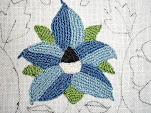We started Wednesday morning with warm up samples and then moved on to the actual jacket pieces. We all started with leaves or buds outlined with reverse chain and filled with detached buttonhole stitch. The filling is quite dense and looks beautiful done in the twisted silks. We were all lucky to be able to look at what the June group had stitched. Here is one part of the room as we started stitching.

I was working on the left underarm piece of the jacket. It had not been worked on because they had only just acquired enough large frames to stretch all the pieces. It was nice to have a new piece because at the end of it all, I knew everything on the piece was done by my - not that there was much done, but it was still nice.
Our first evening program was a needlebook kit with a design by Wendy White on a Tokens and Trifles card with a customized back that commemorates our stitching session.. The pattern was special - based on one of the two samplers in the Plimoth Plantation collection that we were able to see in person the next day.
On Thursday, as well as having the chance to see a real stumpwork piece close up, we had a behind the scenes tour of the Plimoth Plantation collections department with Karin the curator in charge of the collections. She brought out a selection of needlework and clothing related items to show us, along with the two samplers. She also told us about a wonderful book, Findings: The Material Culture of Needlework and Sewing, by Mary C. Beaudry. I purchased the book and it is wonderful (more in another post). There was a large shelf of pieced together pottery that had been recovered from privy digs - a useful place to study the past.
We also had our show and tell time. It was wonderful to see everyone's work. I have so many ideas for things to make - as always I'll write them down or I will forget them before I ever get the chance to work on them.
Later in the day, Jill Hall took us to the wardrobe workshop and showed us where they clothe the 50-60 English settler interpreters at Plimoth Plantation. There is a separate wardrobe department for the Native People who wear Wampanoag dress.
So here is my completed underarm piece. As you can see, three days of stitching doesn't cover much ground when you are working with detached buttonhole and getting used to a floor frame. Mind you I did take breaks and had time off for meals and shopping. I imagine the women who made these jackets back in the 16th and 17th centuries didn't have so much time off and I know their meals weren't as nice as the ones we had.
I can't tell you how exciting it was to talk with Tricia Wilson Nguyen about the project. She is very excited by all the technical details and knowledgeable about the threads. It was fascinating to hear about how she researched the threads used and how she was able to get gold wrapped thread for the project. And the gold wrapped thread was great fun to work with. The two pink strawberries are done with the carnation colour.
Everyone at Plimoth Plantation was great. Jill and her staff in the Colonial Wardrobe Department (and Jill's two lovely daughters) did so much for us. And all the other stitchers were so nice and it was inspiring to hear about all their projects and the classes they had taken. I realized that despite my many years of stitching, I really am just a neophyte when it comes to real historical stitching. A few reproduction samplers is nothing compared to the work many of the other participants are doing. It was a real learning experience all around.



1 comment:
Thank you for your comment on my TAST French Knots.
Thanks also for the link to the embroidered jacket project. Wow, what a wonderful project to be part of. What happens now, do you get to complete this underarm section?
CA
Post a Comment